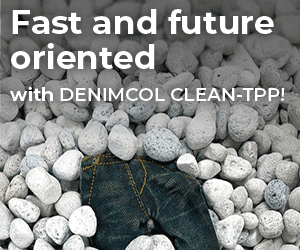These aren’t just any jeans

UK-based retailer M&S has spent two years revamping its denim fabrics, dyes and wash processes, and is rolling the new standards out across all its ranges.
Advances in technology and chemicals, and new evidence that sustainability increasingly matters to its customers are among reasons Marks and Spencer chose two years ago to embark on a complete overhaul of its denim collections. The UK-based retailer sought to make improvements in fabrics, chemicals and wash processes, working with its mill and laundry partners to set and meet new targets.
M&S describes denim as one of its most popular “hero categories”. It reportedly sells one in 10 pairs of jeans in the UK and has seen continued demand for denim throughout the pandemic, in particular for its bestselling jeggings, of which it sells two pairs every minute. Earlier this year, it launched 46 websites in new markets, expanding its online reach and enabling “millions more” customers to purchase its products, with the Sienna Straight Leg Jean topping its bestseller list across multiple international markets.
Choices of raw materials, dye and wash selection can have a big impact on the footprint of every garment, according to senior sustainability manager Cerian Atwell. “That’s why we chose to look at denim,” she tells Inside Denim, “as we could have a positive impact with simple actions.”
M&S worked with technology company Jeanologia, using its Environmental Impact Measuring (EIM) software to track each style against four metrics: water, energy, chemical impact and worker impact. The partners worked on reducing water using a combination of new machinery, eliminating some of the wash steps and encouraging the adoption of water recycling technology.
It is phasing out powdered indigo and adopting pre-reduced indigo, which uses less water and fewer chemicals at mill level. Another target has been to eliminate potassium permanganate spray, which has a high impact profile when it comes to the environment, as well as health concerns for workers, particularly if they do not use the right protective equipment, says Ms Atwell. “More than half the styles that were sprayed for our spring 21 range used an alternative, lower-impact spray.”
Adding efficiency
Often when more sustainable technologies are adopted, it is a balancing act of where any extra costs are absorbed – by the mills, laundries, retailers or consumers. M&S’s customer surveys showed people do not necessarily want to pay more for their clothes, but still expect the company to source with care. “One of the promises we make is ‘trusted value’,” she says. “We don’t necessarily see that if we increase the sustainability attributes that that will impact the price. We do so much work in the background, we need to share that with our customers.”
Ms Atwell believes laundries are open to investing in newer technology because it is more efficient. “Ten or 15 years ago the technology didn’t exist, but because technology is improving, the laundries are modernising. So, it’s a combination of new technology and improvements in chemistry combining to make it the right time to do this.”
Following an initial scoping project, it took a further two seasons to scale the new standards to the full denim programme and this season the retailer was able to makes its specific claims, backed by data, and launch a big marketing campaign. More than five million pieces of denim were measured through the EIM software program in 2020, and those for autumn-winter 2021 are currently in production.
Future proof
In terms of fabrics, most cotton is sourced through the Better Cotton Initiative – the company estimates 18 billion litres of water was saved through its sourcing of BCI (compared with conventional cotton) in 2019. Before the covid-19 pandemic, the team regularly attended fabric fairs but now rely on presentations from key suppliers. “For the new technologies in raw materials and chemistries, we normally invite suppliers to present these to us and then we set up projects with our partners to trial them,” says Ms Atwell.
The next steps include completing the transition away from potassium permanganate spray and considering newer chemistries. “We are also looking at circular principles and how they can be applied; fibre-to-fibre recycling as well as how the jeans are designed, so they can be recycled at the end of their life,” adds Ms Atwell. “Our work with denim isn’t done yet.”
The new standards apply across all segments: women’s, men’s and childrenswear.
Credit: M&S












